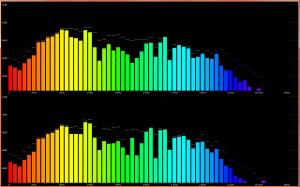Think that copy of The Doors’ first album is the same as the one your neighbor has?
Hmm. Interesting.
Think you’re both hearing “Light My Fire” the exact same way?
Well, think again, my friend! Of course, it’s entirely possible you each have the same edition, but if you include all formats (records, tapes, CDs, streaming) there are easily a dozen versions with variations both subtle and massive. And it’s not only that album, it’s the majority, especially the further back you go, and even more so with the most popular titles. What the hell am I talking about? Let’s investigate.
The easiest variation to identify — usually it’s labeled, but if not you can tell quickly by using headphones: if you hear a guitar, for instance, only on the left side, then it’s stereo, and if you’re hearing the same thing in both ears, it’s mono. From about 1958 through 1968, most albums were released in both mono and stereo. Think of the mono sound as being built like a layer cake (mmm, cake); and then the stereo has all the same layers, but divided into two cakes (mmm, two cakes).
Mono can sound a little punchier, a little more rockin’, but stereo can give you a nice separation of instruments, like you’re in the studio. Almost all the classic rock and pop albums from the 60s were released in both formats. Some songs sound much better in mono, some in stereo. Others sound good no matter what.
It’s worth finding copies of your favorite albums in both formats. Actually, if there’s an album you don’t think sounds good, you may want to find its other half and see if it changes your mind.
Think that CD of Rubber Soul by The Beatles lets you hear it the way it was originally released? Nope. Not unless you’ve got the mono box set and you had the mono album as a child. When they released Rubber Soul (and Help!) on CD in 1987, the album was remixed — the placement of the vocals and instruments in the “stereo picture” (i.e. what’s left, center, and right) was changed and digital reverb added. They still used those mixes when the albums were reissued in 2009.
Luckily, albums aren’t usually entirely remixed and they’re generally labeled as such when they are. Sometimes the new mix is virtually indistinguishable from the original, but sometimes (as is the case with the Perception box set by The Doors) entirely new elements are introduced, such as a tambourine, or a horn section, or a guitar riff, which may have been recorded at the time but dropped from the final mix. These alternate mixes sometimes show up as bonus tracks on reissues.
By far the most common variation. Mastering generally deals with the frequency spectrum (your bass, mids, and treble) and compression (think of it as squeezing the audio signal — a little can make a section pop, too much can erase any dynamics). A good mastering job should make the music come alive and sparkle, whereas bad mastering can make the music dull or shrill or fatiguing.
Albums are often remastered when an artist switches record labels and they reissue the whole catalog. Very popular albums sometimes receive remastering by audiophile labels if the artist and label approve.
As an example, The Beatles’ entire catalog has been mastered for CD three times, twice for the stereo and once for the mono. David Bowie’s 70s catalog (if I’m figuring correctly) has been mastered for the digital realm six times. That’s six different ways to hear the sonic signature of each album. Also, just for fun and confusion, some of David’s albums have received remixes. And I’m not including the separate variations for vinyl.
Anyway, just something to keep in mind. There are many different ways to hear the same song.


